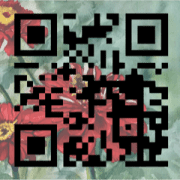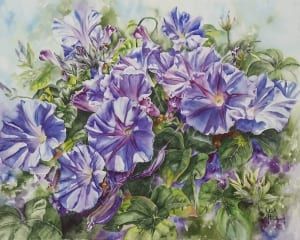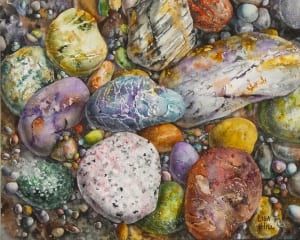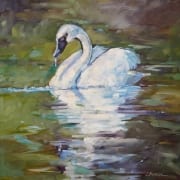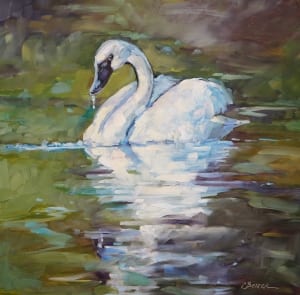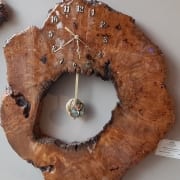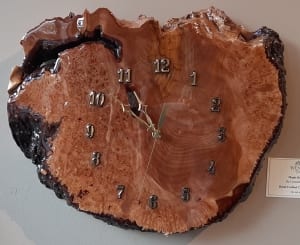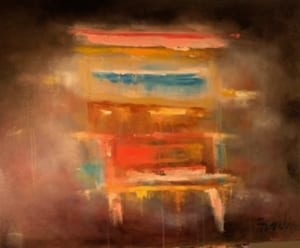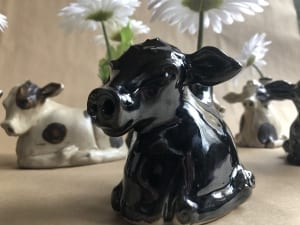QR Code Art — Lorna Barth’s Paintings Tell a Story

Dayton watercolor painter Lorna Barth embedded the QR Code for the framed print, At Last, Deer Yorick, in the lower left-hand corner of the print. Viewers scanning the code with their phone or tablet access the story behind the artwork.
We’re all hearing a lot about QR codes these days.
For the uninitiated, QR codes are matrix barcodes that smart phone or tablet cameras “read” when we point and scan. The square blocks of contrasting dark and white shapes contain long strings of information data — such as an Internet link leading to a web page — and eliminate the need to accurately type in all the letters, numbers, and symbols of the actual link.
“QR codes have been used for decades,” says Dayton, WA, watercolor artist Lorna Barth, who has developed a unique way to integrate them into her paintings.
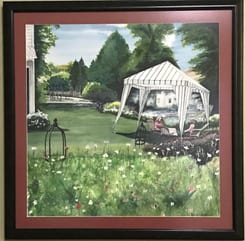
After the Quilt Show, original watercolor painting by Lorna Barth. On her original watercolor paintings, Barth affixes the QR code to the painting’s video to the artwork’s back.
“These little codes have become instant transport for almost everything from your grocery receipt to the information on any product.
“But they are SO BORING!
“And they take you to BORING PLACES. Or to places that sell you things, or boring information that nobody ever wants to read.”
So one day, while she was painting, she had an epiphany:
“What if they went to Art? or Poetry? or Both? It would give people just a little minute or two of respite to look at art, listen to gentle music, and chill without a sales pitch or ‘Subscribe,’ or anything. Random phone art.”
Innovating with Old and New
And from that moment, her lifelong art journey took a new direction. She combined old with new: paper and watercolor paint — items that have existed unobtrusively for centuries and millennia — with contemporary tech. Now, in many of her works she incorporates a QR code. With original paintings, she places the QR code on the back. With prints, she integrates it onto the substrate and into the image. Other times, she paints it as a separate painting to accompany the artwork.
Where it leads varies as well, but the destination, Barth is happy to say, isn’t boring.
“For many of my works, I make YouTube videos of the painting being done, or lead into the work to give the viewer an extended view of this piece of art,” Barth explains.
“These are not instructional videos, but time with the artist and the artwork in the creation of it.”
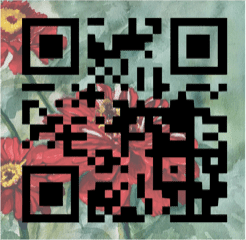
Sometimes, Barth paints the QR code as a separate painting of its own. It then accompanies the work it describes. This is the code for the Bee and Zinnia nested art blocks series.
The codes themselves, she says, are independent artwork of their own, leading to other worlds and stories.
“The QR codes that accompany my paintings attest to the originality and authenticity of my work.
“They are short performance videos to go along with and tell the story behind the art the viewer is engaging with visually. They add a new level of engagement to the experience.”
Enjoying Art at the Bus Stop
This means, she adds, that her paintings impact in a multitude of places, not just the wall where they are hanging. Digitally, viewers access her art on the bus, at soccer practice, in a waiting room, over lunch with friends.
“The technology as part of the art has taken the art and put it in the hands (quite literally) of multiple viewers at the same time.”
As with all technology, there are glitches. Barth recalls the time she painted in plein air, on a golf cart at the Touchet Valley Golf Course in Dayton. After finishing the painting on site, she discovered that her tablet video camera had mysteriously stopped right after she started, and the only digital record she had was of her getting the paper wet prior to the first brush stroke. Other times, though the camera is rolling, Barth gets so involved in the creation of the piece that she forgets she is being recorded.
“My memory will be full, and the painting will be completed without any documentation.”
But the glitches are part of the journey. Every technical hiccup is an opportunity to learn, adjust, and finesse. And the ultimate result is worth it, because the fusion with technology adds dimension to the artwork, thereby enhancing the experience of both artist and viewer.
Multi-media and Multi-layer
“One of the most fulfilling aspects of multimedia artwork is the ability to experience the art on many levels.
“Yes, they are paintings, but there was so much more that went along with the creation of them. There was the place, the method, the action of painting, music, and then the travel of the artwork to multiple venues.”
This blend of old and new — watercolor and QR codes leading to video — is the perfect combination, Barth says.
“It makes artistic expression take on multiple layers of experience and transportability that has never before been available until the digital age.”
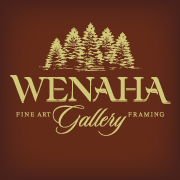 Lorna Barth is the featured Art Event at Wenaha Gallery from May 4 through May 31, 2021.
Lorna Barth is the featured Art Event at Wenaha Gallery from May 4 through May 31, 2021.
Contact the gallery, located at 219 East Main Street, Dayton, WA, by phone at 509.382.2124 or e-mail art@wenaha.com. Gallery hours are 9 a.m. to 5 p.m. from Monday through Friday, and by appointment. Visit the Wenaha Gallery website online at www.wenaha.com.

